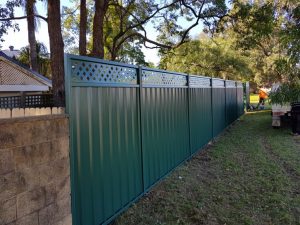Introduction
Choosing the ideal height for your Colorbond fence can be a complicated task, specifically with numerous options offered. After all, a fence isn't just a boundary; it's a declaration about your property. It provides personal privacy, security, and visual appeal. In this thorough guide, we'll stroll you through everything you require to understand about selecting the best height for your Colorbond fence. From understanding local policies to considering your particular needs, we've got it all covered!
What is a Colorbond Fence?
A Colorbond fence is made from high-quality Colorbond steel that is pre-painted and comes in numerous colors and designs. It's understood for its durability, low maintenance requirements, and elegant look. The charm of Colorbond fencing lies in its versatility; it fits well with various architectural styles while providing robust defense against the elements.
Why Pick Colorbond Steel for Fencing?
When it comes to fencing products, why should you go with Colorbond steel? Here are numerous engaging factors:

How to Pick the Right Height for Your Colorbond Fence
When thinking of how to pick the ideal height for your Colorbond fence, consider several elements that affect the perfect height.
1. Regional Regulations and Zoning Laws
Before choosing the height of your fence, it's crucial to inspect local policies and zoning laws. Different areas have differing constraints relating to residential fencing heights.
- Standard Heights: Many towns allow fences as much as 1.8 meters (approximately 6 feet) in residential zones. Permits: Some locations might require licenses for greater fences or specific materials.
Consulting with regional authorities ensures compliance and avoids potential fines or elimination orders.
2. Function of the Fence
Understanding the function of your fence plays a vital role in identifying its height:
- Privacy: If you want maximum privacy from next-door neighbors or passersby, think about at least 1.8 meters. Security: For security purposes, taller fences can function as efficient deterrents against intruders. Aesthetic Appeal: In some cases a lower fence may be enough if you're aiming for curb appeal rather than function.
3. Landscape Considerations
The surrounding landscape can likewise dictate what height might work best:
- Sloping Terrain: If your residential or commercial property has uneven ground, you might need a taller fence on one side than the other. Vegetation: If there are high trees or shrubs close by, they could obscure views and impact how high your fence requires to be.
4. Surrounding Properties
It's important to consider neighboring homes when selecting your fence height:
- Sightlines: A greater fence might block views from neighboring homes, which might result in disputes. Cooperation with Neighbors: Interacting with next-door neighbors before deciding can promote goodwill and prevent conflicts.
5. Style Preferences
The style of your home will influence what height looks finest:
- Modern Homes: Streamlined lines normally match well with taller fences. Traditional Homes: Lower fences may match traditional architecture more effectively.
Common Fence Heights Explained
Understanding typical heights can simplify the decision-making procedure:
|Fence Height|Normal Use|| --------------|-------------|| 1 meter|Ornamental or garden fencing|| 1.2 meters|Low personal privacy; suitable for front lawns|| 1.5 meters|Moderate personal privacy; typical choice|| 1.8 meters|Standard height for complete privacy|| 2+ meters|Maximum security; often needs licenses|
Color Choices for Your Colorbond Fencing
When picking a color for your Colorbond fence, keep these ideas in mind:
6. Popular Colors
Color choices significantly impact the overall visual of your home:
- Classic colors like Surfmist or Wilderness mix well with natural surroundings. Bold shades such as Cottage Green stand out beautifully versus contemporary architecture.
7. Long-term Appeal
Consider how well each color will age with time:
- Lighter shades may reveal dirt more quickly however can brighten up spaces. Darker colors may fade however provide a sophisticated finish.
FAQ Section
FAQ # 1: What is the optimum allowed height for a domestic fence?
The optimum allowed height differs by town however generally varies from 1.2 meters (4 feet) to 1.8 meters (6 feet).
FAQ # 2: Can I build my Colorbond fence greater than my neighbor's?
While it's legal in most cases to develop greater than surrounding properties if certified with regional guidelines, it's advisable to seek advice from them first.
FAQ # 3: Do I need an authorization to set up a Colorbond fence?
It depends upon regional regulations-- some areas do require licenses based on height or place near property boundaries.
FAQ # 4: Exists any maintenance required on a Colorbond fence?
Colorbond fences are rather low-maintenance; occasional cleansing with water is normally enough to keep them looking fresh!
FAQ # 5: For how long does a Colorbond steel fence last?
With proper setup and care, you can expect a lifespan of over 20 years!
FAQ # 6: Can I paint my existing Colorbond fence?
While repainting isn't normally suggested due to service warranty problems, some specialized items allow touch-ups without impacting integrity.

Conclusion
In summary, understanding how to choose the best height for your Colorbond fence includes considering guidelines, functions, https://outstandingfencing.com.au/colorbond-fencing/northern/craigieburn/ landscape features, next-door neighbor interactions, design preferences, and color choices-- all coming together wonderfully! When prepared properly-- these factors will help develop not simply any normal barrier-- however rather an extension of your home that supplies security while enhancing looks as well.
So whether you're trying to find total privacy or just want something aesthetically pleasing-- there's a perfect solution waiting just around the corner!